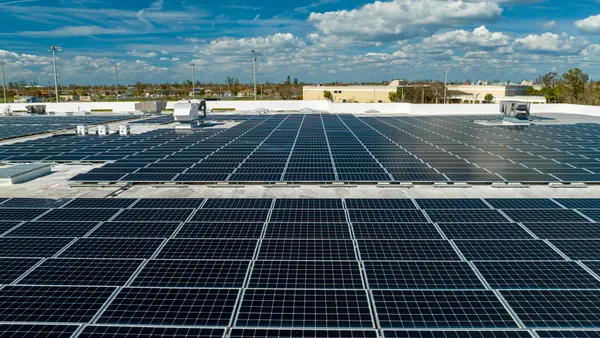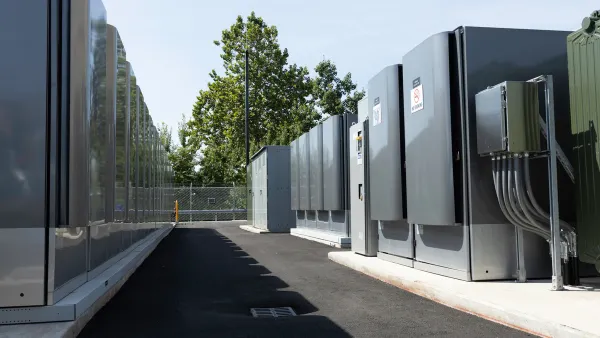Opower's long-awaited, much-hyped initial public offering (IPO) is finally here. Today's offering of 6.1 million shares at $19 per share will raise an estimated $116 million for the company and give it a valuation of nearly $1 billion. Opower (NYSE: OPWR) opened at $25 per share and ended the day at $23.09.
But there's a reason for all the hype: Opower’s IPO isn’t just about, well, Opower. Everyone from Wall Street to Silicon Valley is eyeing the energy-data nexus as the next big opportunity – but identifying opportunity and building successful business models around it are different stories.
Opower, the market leader in residential efficiency, is one of the success stories. But what made Opower -- unlike so many other promising startups -- so successful? And what’s next for Opower and the energy-data opportunity?
Reached for comment, Opower told Utility Dive it could not participate in any interviews ahead of its IPO.
The Opower success story
When Opower was founded in 2007, it started out with a simple goal, CEO Dan Yates told Utility Dive in a recent interview: “What if we could make a better utility bill?” Its mission today -- "to motivate everyone on earth to save energy" -- is a little more ambitious.
The company raised $65 million to build a business model around energy efficiency and utility customer engagement. Opower's IPO today represents the culmination of that investment -- but how did they get here?
Opower discovered early on that the best way to motivate consumers to save energy is not financial savings or doing good for the environment -- it's neighborly competitiveness.
"The only two things consumers want are a low bill and the lights on," Yates said. "Consumers think about their energy consumption six minutes a year. We get it — customers do not care about this stuff.”
Opower partners with utilities to provide them with a platform that marries behavioral science with data analytics to engage utility customers through personalized energy reports that compare their energy use to that of their neighbors.
This approach is working. Opower has partnered with 93 utilities -- including eight of the 10 largest utilities in the U.S. -- and reached 32.1 million electricity consumers around the globe. While the company's growth efforts saw it lose $14.2 million in 2013, its revenue jumped from $28.7 million in 2011 to $88.7 million in 2013, according to its S-1 filing.
"With automation, you know what you're going to get. But the challenge is those models typically only get about 20% of the addressable market within a utility's service territory," Bud Vos, then-COO of Simple Energy and now-CEO of ENBALA Power Networks, told Utility Dive earlier this year. "The behavior-based programs go after the other 80%."
The market is ripe for Opower's model
A convergence of disruptive forces such as rooftop solar and energy efficiency are causing utilities and regulators to rethink the tried-and-true way of doing business.
Utilities are not accustomed to marketing their services – they have quietly and reliably provided power from behind the meter for the last century. The problem for utilities is that customers today have more choice, but they have a generally poor perception of the incumbent utility -- and a typically positive perception of, say, rooftop solar providers.
As utilities look to mitigate these disruptive forces, some are making the transition to a customer-centric model. Opower’s products -- which utilities can brand for themselves -- go a long way to helping utilities do just that.
Opower's "data-driven energy efficiency play" is part of the "software-ification of the utility-customer relationship," Tendril CEO Adrian Tuck told Utility Dive.
"Opower was very smart about focusing on software and services from the very beginning, and not having a capital-intensive element to what they’re doing," ThinkEco CEO Jun Shimada told Utility Dive. "The important thing is how they capture the revenues from utilities. Often they went through budgets that did not necessarily require regulatory approval, which is a key step that helped keep their sales cycles reasonably short and allowed them to continue to approach many utilities at same time."
While Opower's solutions can help utilities transition their business models, a big part of what made Opower so successful is that -- unlike so many other cleantech startups -- Opower found a way to apply software inside the existing utility model, according to Tuck.
"Most of the rest of us have been trying to focus on getting utilities to change," he said. "What Opower did really well was say: 'We can do this within the existing construct of how utilities think.'"
"If I could wind back the clock," Tuck observed, "I would probably do it myself."
Solving disruption with energy efficiency
Another factor that's creating demand for Opower's business is the rise of energy efficiency.
Efficiency mandates are being passed with increasing regularity in states, while demand response is increasingly becoming a first-call resource, instead of just being emergency backup. Utilities are struggling with the rise of efficiency and the demise of business models based on electric sales, but Opower CEO Dan Yates recently explained why he believes energy efficiency can help solve problems for utilities.
"There's two paths we can go down," Yates explained. "Path A is: The utility keeps their heels dug in and resist [the transition to a clean energy future], and all the distributed generation guys start to pick off all their highest value customers, which is happening. The utility's grid costs pro rata will keep creeping up. They will have less and less capacity to afford more expensive distribution, transmission and generation because they'll become less and less cost effective. And then, the distributed generation guys will just go creeping down the stack and we'll end up in a distributed generation world with no centralized utility."
"Alternatively," Yates said, "utilities can lean in and go way in on efficiency, which drives down costs to keep rates low enough that they can then reraise the rates to bring in more and more cost-effective renewables. Utility-scale solar and wind—these are so much more cost-effective than distributed solar by a factor of three. It’s crazy that the utilities aren’t offering low-cost solar to the guys that are popping off the grid right now."
Opower is one of the first companies to really figure out residential efficiency and is currently pioneering behavioral demand response. There's a big market for these services -- and it's largely untapped.
“Opower validates the hypothesis that energy efficiency can have a valid business model behind it," ThinkEco CEO Jun Shimada told Utility Dive.
The chips will likely continue to fall in Opower's favor as regulators and policymakers call for more energy efficiency and more demand response. While competitors will inevitably catch up to some degree, Opower already has a big early lead.
Opower's future
Opower plans to use its IPO to pay back investors and grow the business.
In all, Opower sees an opportunity to capture at least $2.2 billion in savings on U.S. utility bills. The company believes it can reach 1,300 utilities, or 650 million residential customers and 60 million commercial customers. "If that's the case, the company hasn't even reached one-tenth of its market potential," according to Greentech Media writer/analyst Stephen Lacey.
Opower has recently taken behavioral demand response to scale with Baltimore Gas & Electric, expanded its efficiency platform to small-to-medium-size businesses (a notoriously hard-to-reach segment), and is working on a smart thermostat with Honeywell.
Despite the promise of these new products, Opower notes in its S-1 it has "yet to see a significant return" on its smart thermostat. The company concedes that "it is possible that the market [for its behavioral demand response product could be smaller than we have expected or that our product will not function as intended." And the "market for [Opower's small commercial product] is unproven."
"In the past, we have experienced delays delivering products, and while we have taken steps to improve the predictability of our research and development efforts, those efforts may not be successful. If we continue to experience delays in our ability to deliver new products and functionality, our business and growth rates would suffer," Opower wrote in its S-1.
Opower has an early lead in the behavioral efficiency and customer engagement space, but more competitors are jumping into these emerging markets. A source told Greentech Media (GTM) that Opower's "internal management is constantly worried about competition and is sensitive to any new market entrants that gain traction." Google's recent acquisition of Nest "presumably" had that effect, GTM's Stephen Lacey noted.
"The beauty of what made Opower so successful in this first phase might – if they’re not careful – become a curse on the next phase," Tuck said. The success of Opower's behavioral efficiency product has "been about compliance" but "it doesn't really impact the bottom line."
Helping utilities use data to offer customers new services could be Opower's next play, according to ThinkEco CEO Shimada.
"Because Opower touches so many utility customers through billing, I think the next step for them would be to try to monetize that access to customers through the billing process by hooking it up with energy efficiency services and retrofits – rebates, for example," he said. "Right now there’s no real connection between those two segments. That to me is a natural direction."
One issue facing Opower is its reliance on its 10 largest utility clients, which make up 61% of the company's revenue. Another big question is: Can Opower move beyond its utility client base, which makes up 90% of its revenue? As the grid becomes more decentralized, managing the back-and-forth power flow from the grid to the home and vice-versa will become critical – and a major opportunity for companies like Opower.
"I’m going to say 'qualified yes,'" Tuck said. "Opower’s model is a regression-based statistical model, which means that the natural place to go to provide services is the guy who has all the data. Opower’s solution has more value to somebody like a utility who has all the meter data, and less value to, say, Comcast or SolarCity, who might be looking to get into the market but doesn’t have the data."
What Opower's IPO means for cleantech
Opower’s IPO is yet another sign that the cleantech space is starting to mature and gain access to financing opportunities.
Amid a lot of negativity around the sector, we're still seeing companies growing and succeeding," Rob Day, a partner at Black Coral Capital, told Greentech Media. "We're going to see more of these -- it's a taste of what's to come."
Stuart Bernstein, global head of Goldman Sachs' Clean Technology and Renewables Group, expects between "half a dozen to a dozen" cleantech companies to IPO this year, noting that some have already registered IPOs confidentially as Opower just did, according to the Wall Street Journal.
“Opower's success gives a trail for many younger companies to do much more on the path Opower has opened up by making utility dollars available to behavioral science. That paves the way for many more innovations to come – and be accepted in the utility space at a massive scale," Bidgely CEO Abhay Gupta told Utility Dive. "I think we’re just scratching the surface in terms of analytics and what we can do with the data."













